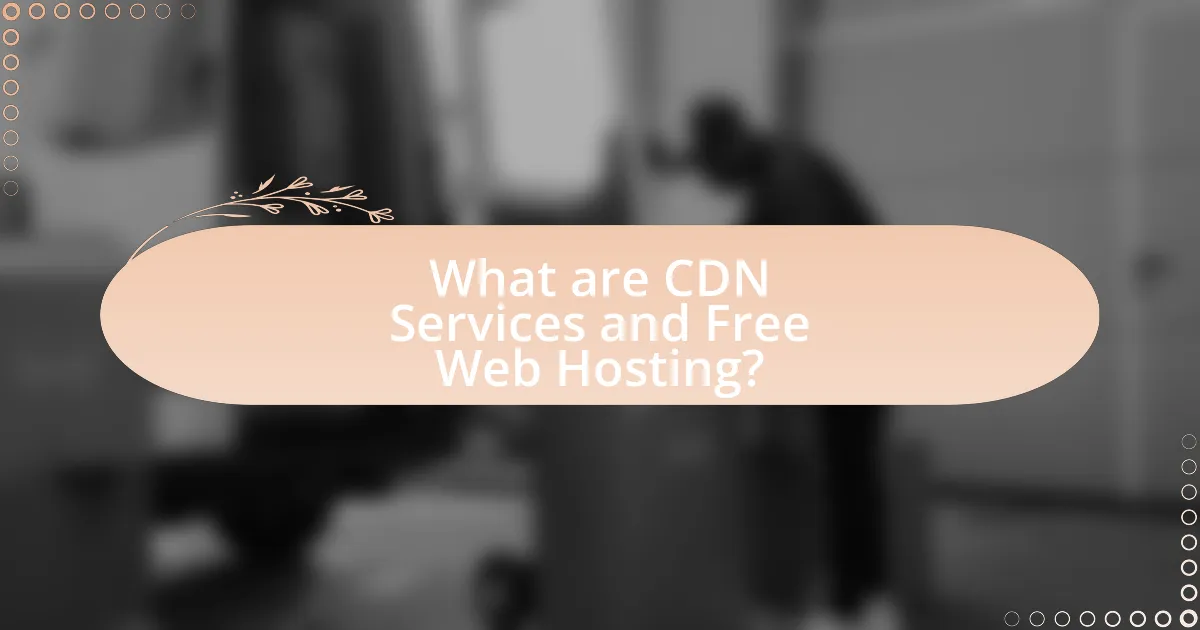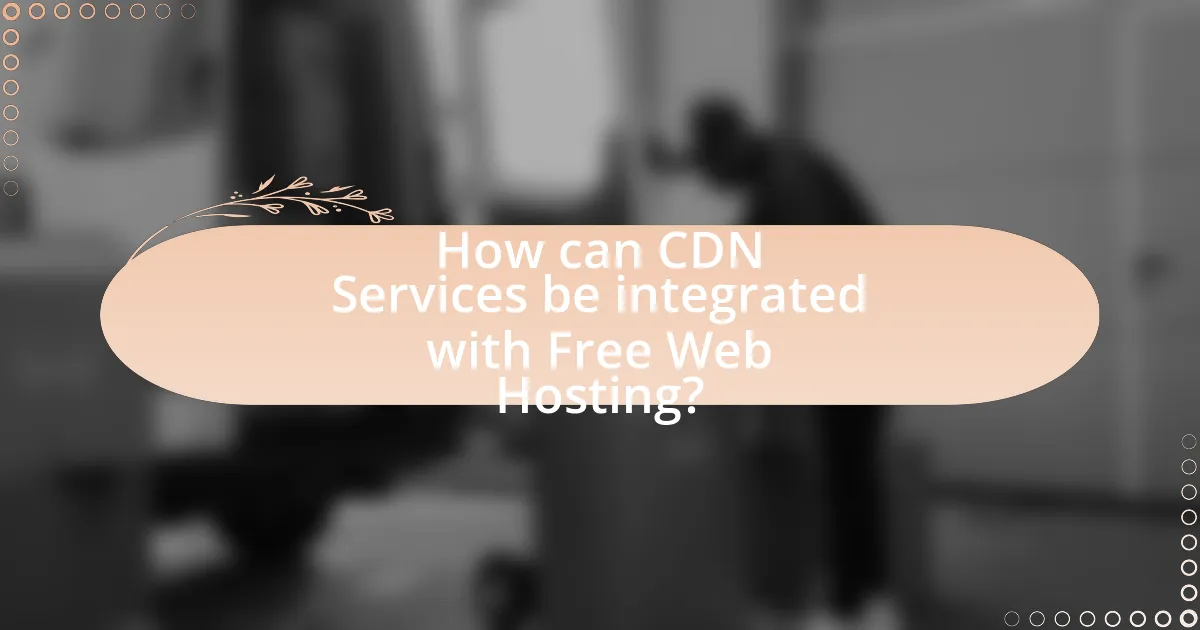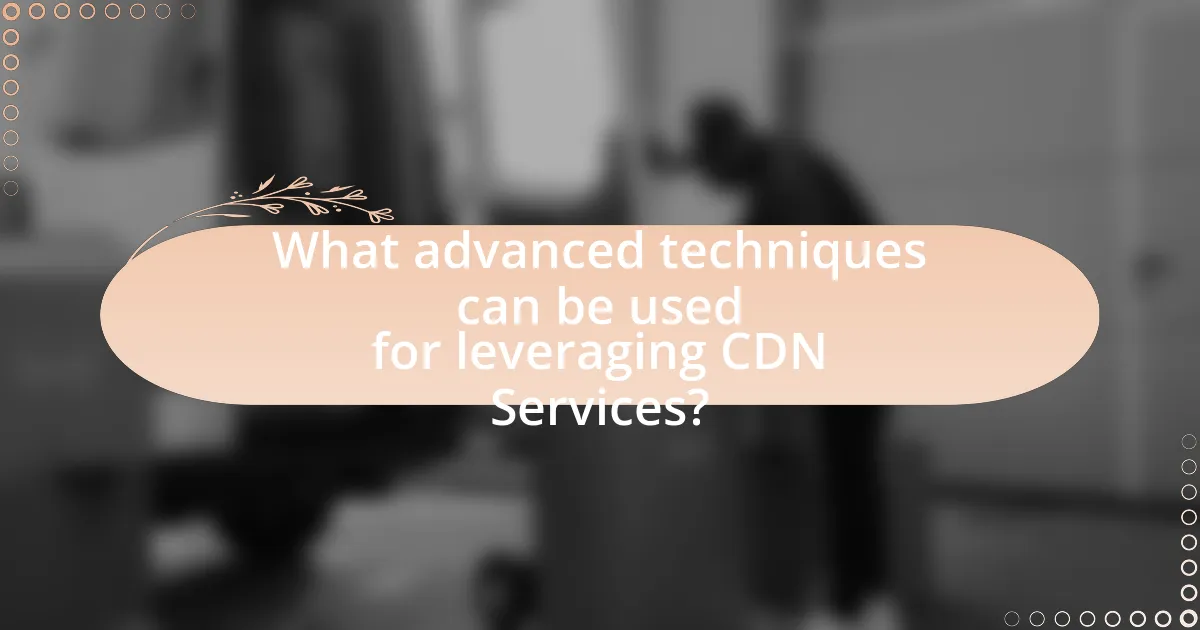CDN services, or Content Delivery Network services, are essential for enhancing website performance by distributing content across multiple servers globally, thereby reducing latency and improving load times. This article explores the integration of CDN services with free web hosting, highlighting the benefits, limitations, and key features of both. It covers how CDN services can optimize website performance, the role of free web hosting in website management, and the steps necessary for successful integration. Additionally, it addresses challenges that may arise during integration, best practices for maintaining performance, and advanced techniques for leveraging CDN services effectively.

What are CDN Services and Free Web Hosting?
CDN services, or Content Delivery Network services, are systems that distribute web content across multiple servers located in various geographical locations to enhance the speed and reliability of content delivery. By caching content closer to users, CDNs reduce latency and improve load times, which is crucial for user experience and SEO performance. Free web hosting, on the other hand, refers to hosting services that allow users to publish websites without incurring costs, typically offering limited resources and features compared to paid hosting options. Many free web hosting providers may also integrate with CDN services to optimize performance, even on a budget, making it easier for users to deliver content efficiently.
How do CDN Services enhance website performance?
CDN services enhance website performance by distributing content across multiple servers located in various geographical locations, which reduces latency and improves load times for users. By caching static content closer to the end-users, CDNs minimize the distance data must travel, resulting in faster access to website resources. For instance, a study by Akamai found that a 100-millisecond delay in load time can decrease conversion rates by 7%. This demonstrates that CDN services not only improve speed but also positively impact user engagement and business outcomes.
What are the key features of CDN Services?
Key features of CDN services include content caching, global distribution, and improved load times. Content caching allows static resources to be stored on multiple servers, reducing the distance data must travel to reach users. Global distribution ensures that content is delivered from the nearest server location, enhancing performance and reliability. Improved load times are achieved through optimized routing and reduced latency, which can lead to faster page loading and a better user experience. According to a study by Akamai, websites utilizing CDN services can experience up to a 50% reduction in load times, demonstrating the effectiveness of these features.
How do CDN Services reduce latency for users?
CDN services reduce latency for users by caching content at multiple geographically distributed servers, allowing users to access data from a server that is physically closer to them. This proximity minimizes the distance data must travel, resulting in faster load times. For instance, a study by Akamai found that reducing the distance between the user and the server can decrease latency by up to 50%. Additionally, CDNs optimize data delivery through techniques like dynamic content acceleration and TCP optimization, further enhancing performance and reducing delays.
What is the role of free web hosting in website management?
Free web hosting plays a crucial role in website management by providing a cost-effective platform for individuals and small businesses to establish an online presence without financial barriers. This service allows users to host their websites at no charge, enabling them to manage content, design, and functionality while minimizing initial investment costs. According to a report by Statista, as of 2023, over 30% of websites are hosted on free platforms, highlighting their significance in democratizing access to web resources. Additionally, free web hosting often includes basic features such as website builders, limited storage, and bandwidth, which facilitate the management of websites for users with varying technical skills.
What are the limitations of free web hosting?
Free web hosting has several limitations, including restricted storage space, limited bandwidth, and lack of customer support. These constraints can hinder website performance and scalability, as many free hosting services impose strict quotas that can lead to slow loading times or downtime during traffic spikes. Additionally, free web hosting often includes mandatory advertisements, which can detract from the user experience and brand image. Security features are typically minimal or non-existent, increasing vulnerability to cyber threats. Furthermore, users may face restrictions on custom domain usage and limited access to advanced features, which can impede professional growth and functionality.
How does free web hosting compare to paid options?
Free web hosting typically offers limited resources, features, and support compared to paid options. Paid web hosting services generally provide enhanced performance, greater storage capacity, better security measures, and customer support, which are crucial for businesses and professional websites. For instance, a study by HostingAdvice found that paid hosting plans can offer uptime guarantees of 99.9% or higher, while free hosting often lacks such reliability. Additionally, paid options frequently include advanced features like SSL certificates and custom domain names, which are essential for establishing credibility and trust online.

How can CDN Services be integrated with Free Web Hosting?
CDN services can be integrated with free web hosting by configuring the DNS settings to point to the CDN provider and updating the website’s resource URLs to use the CDN’s domain. This process typically involves signing up for a CDN service, obtaining the CDN URL, and replacing static resource links (like images, CSS, and JavaScript files) in the website’s code with the CDN URL. Many free web hosting platforms support this integration, allowing users to enhance their website’s performance and load times by distributing content across multiple servers globally. This method is validated by the fact that major CDN providers, such as Cloudflare and Amazon CloudFront, offer straightforward integration guides specifically designed for users of free web hosting services.
What are the steps to set up CDN with free web hosting?
To set up a CDN with free web hosting, first, choose a CDN provider that offers a free tier, such as Cloudflare or AWS CloudFront. Next, create an account with the chosen CDN provider and configure your CDN settings, including adding your website’s domain. After that, update your DNS records to point to the CDN, which typically involves changing the nameservers to those provided by the CDN. Finally, test your website to ensure that content is being served through the CDN, verifying improved load times and performance. These steps are essential for effectively leveraging CDN services with free web hosting.
How do you choose the right CDN provider for free hosting?
To choose the right CDN provider for free hosting, evaluate the provider’s performance, reliability, and features. Performance is crucial; select a CDN that offers low latency and high-speed delivery, which can be assessed through user reviews and performance benchmarks. Reliability is also essential; opt for a provider with a strong uptime record, ideally above 99.9%, as indicated by industry standards. Additionally, consider features such as global coverage, security options like DDoS protection, and ease of integration with your hosting platform. Providers like Cloudflare and Fastly are often recommended for their robust free tiers and comprehensive services, making them suitable choices for free hosting environments.
What configurations are necessary for successful integration?
Successful integration of CDN services with free web hosting requires specific configurations, including DNS settings, SSL certificate installation, and caching rules. Proper DNS configuration ensures that the domain points to the CDN, allowing for efficient content delivery. Installing an SSL certificate is crucial for secure connections, especially when handling sensitive data. Additionally, setting appropriate caching rules optimizes content delivery by reducing load times and server strain. These configurations collectively enhance performance and reliability, making the integration effective.
What challenges might arise during integration?
Challenges that might arise during integration of CDN services with free web hosting include compatibility issues, limited bandwidth, and lack of support. Compatibility issues can occur when the CDN does not seamlessly integrate with the existing hosting infrastructure, leading to potential downtime or performance degradation. Limited bandwidth from free hosting services can restrict the effectiveness of the CDN, as high traffic may exceed the hosting provider’s capacity, resulting in slow loading times or service interruptions. Additionally, the lack of technical support from free hosting providers can hinder troubleshooting efforts, making it difficult to resolve integration problems promptly. These challenges can significantly impact the overall performance and reliability of the web service.
How can you troubleshoot common integration issues?
To troubleshoot common integration issues, first identify the specific error messages or symptoms occurring during the integration process. This can involve checking logs, monitoring network traffic, and validating configurations. For instance, if a CDN is not delivering content as expected, verify the CDN settings, including cache configurations and origin server URLs. Additionally, ensure that the integration points between the CDN and the web hosting service are correctly configured, as misconfigurations can lead to failures. According to a study by Akamai, 47% of users expect a web page to load in two seconds or less, highlighting the importance of resolving integration issues promptly to maintain performance and user satisfaction.
What are the best practices for maintaining CDN performance with free hosting?
To maintain CDN performance with free hosting, prioritize optimizing content delivery by using efficient caching strategies. Implementing proper cache control headers ensures that static assets are stored and served quickly, reducing load times. Additionally, minimizing the size of files through compression techniques, such as Gzip, enhances transfer speeds. Utilizing a CDN provider that offers a global network of edge servers can further improve performance by reducing latency for users across different geographical locations. Regularly monitoring CDN performance metrics, such as response times and cache hit ratios, allows for timely adjustments to optimize delivery. These practices are supported by studies indicating that effective caching and content optimization can lead to significant improvements in website performance, even on free hosting platforms.

What advanced techniques can be used for leveraging CDN Services?
Advanced techniques for leveraging CDN services include dynamic content caching, edge computing, and real-time analytics. Dynamic content caching allows CDNs to store frequently accessed data closer to users, reducing latency and improving load times. Edge computing enables processing data at the network’s edge, minimizing the distance data must travel and enhancing performance. Real-time analytics provide insights into user behavior and traffic patterns, allowing for optimized content delivery and resource allocation. These techniques collectively enhance user experience and operational efficiency, as evidenced by studies showing that CDNs can reduce load times by up to 50% and improve site performance significantly.
How can caching strategies improve CDN effectiveness?
Caching strategies significantly enhance CDN effectiveness by reducing latency and improving content delivery speed. When content is cached at various edge locations, it allows users to access data from a server geographically closer to them, minimizing the time it takes to retrieve information. For instance, a study by Akamai found that reducing latency by just 100 milliseconds can increase conversion rates by 7%. Additionally, caching decreases the load on the origin server, allowing it to handle more requests simultaneously, which is crucial during traffic spikes. This efficiency not only improves user experience but also optimizes resource utilization across the network.
What types of content should be cached for optimal performance?
Static assets such as images, CSS files, and JavaScript files should be cached for optimal performance. Caching these types of content reduces load times and bandwidth usage, as they do not change frequently and can be served directly from the cache rather than being fetched from the origin server. According to a study by Google, caching static content can improve page load times by up to 50%, significantly enhancing user experience and site performance.
How does cache invalidation work in CDN services?
Cache invalidation in CDN services occurs when outdated or stale content is removed from the cache to ensure that users receive the most current version of a resource. This process can be triggered by various methods, including time-based expiration, manual purging, or automated rules based on content changes. For instance, a CDN may set a Time-To-Live (TTL) for cached objects, after which the content is considered stale and will be fetched anew from the origin server. Additionally, when content is updated on the origin server, CDNs can use cache purging commands to immediately remove specific cached items, ensuring that users access the latest version. This mechanism is crucial for maintaining content accuracy and performance, as it prevents users from receiving outdated information.
What security measures should be considered when using CDN with free hosting?
When using a CDN with free hosting, it is essential to implement security measures such as HTTPS encryption, DDoS protection, and access control. HTTPS encryption ensures that data transmitted between users and the CDN is secure, preventing interception by malicious actors. DDoS protection is crucial as free hosting services may be more vulnerable to attacks; a CDN can help mitigate these risks by distributing traffic and absorbing attacks. Access control mechanisms, such as IP whitelisting and token authentication, restrict access to sensitive resources, enhancing security. These measures collectively safeguard the integrity and availability of the hosted content while utilizing CDN services effectively.
How can SSL certificates be implemented with CDN services?
SSL certificates can be implemented with CDN services by configuring the CDN to handle SSL termination, which allows secure connections between users and the CDN. This process typically involves uploading the SSL certificate to the CDN provider’s dashboard and enabling HTTPS for the domain. Many CDN providers, such as Cloudflare and Amazon CloudFront, offer automated SSL certificate provisioning and management, simplifying the integration process. For instance, Cloudflare provides free SSL certificates and automatically configures them for users, ensuring secure connections without additional setup. This method enhances website security and improves performance by offloading SSL processing from the origin server to the CDN.
What are the implications of DDoS protection with CDN services?
DDoS protection with CDN services significantly enhances website resilience against distributed denial-of-service attacks. By distributing traffic across multiple servers, CDNs absorb and mitigate the impact of DDoS attacks, ensuring that legitimate users can access the website even during an attack. For instance, Akamai’s CDN reported that it can handle up to 15 terabits per second of traffic, effectively neutralizing large-scale DDoS threats. This capability not only protects the website’s uptime but also maintains user trust and business continuity, as downtime can lead to revenue loss and reputational damage.
What are the best practices for optimizing CDN usage with free web hosting?
To optimize CDN usage with free web hosting, implement caching strategies effectively. Caching reduces server load and speeds up content delivery by storing copies of files closer to users. Utilize browser caching by setting appropriate cache-control headers, which instruct browsers to store static resources locally. Additionally, leverage CDN features such as file compression and minification to decrease file sizes, enhancing load times.
Monitoring CDN performance is crucial; use analytics tools to track metrics like latency and bandwidth usage, allowing for adjustments based on user behavior. Furthermore, ensure that your CDN provider supports HTTPS to secure data transmission, which is essential for user trust and SEO.
By following these practices, you can maximize the benefits of a CDN even when using free web hosting, leading to improved website performance and user experience.